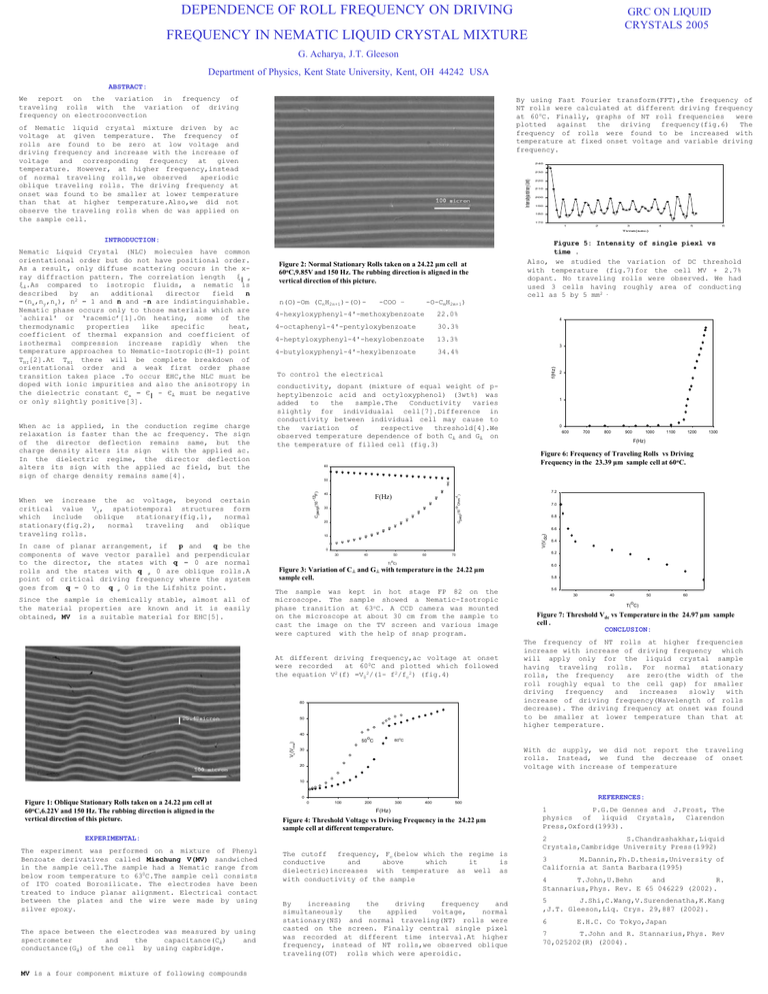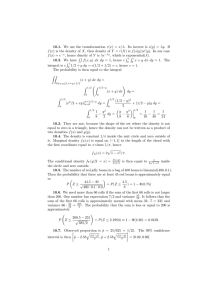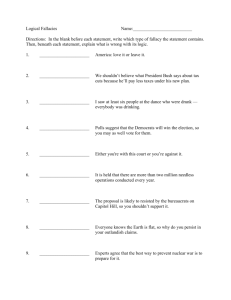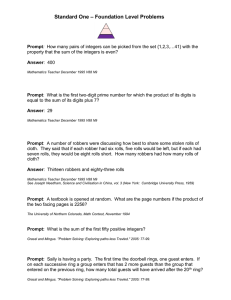DEPENDENCE OF ROLL FREQUENCY ON DRIVING G. Acharya, J.T. Gleeson
advertisement

DEPENDENCE OF ROLL FREQUENCY ON DRIVING GRC ON LIQUID CRYSTALS 2005 FREQUENCY IN NEMATIC LIQUID CRYSTAL MIXTURE G. Acharya, J.T. Gleeson Department of Physics, Kent State University, Kent, OH 44242 USA ABSTRACT: We report on the variation in frequency of traveling rolls with the variation of driving frequency on electroconvection By using Fast Fourier transform(FFT),the frequency of NT rolls were calculated at different driving frequency at 60oC. Finally, graphs of NT roll frequencies were plotted against the driving frequency(fig.6) The frequency of rolls were found to be increased with temperature at fixed onset voltage and variable driving frequency. of Nematic liquid crystal mixture driven by ac voltage at given temperature. The frequency of rolls are found to be zero at low voltage and driving frequency and increase with the increase of voltage and corresponding frequency at given temperature. However, at higher frequency,instead of normal traveling rolls,we observed aperiodic oblique traveling rolls. The driving frequency at onset was found to be smaller at lower temperature than that at higher temperature.Also,we did not observe the traveling rolls when dc was applied on the sample cell. 240 Intensity(arbitrary Unit) 230 220 210 200 190 180 170 1 2 3 4 5 6 Time(sec) INTRODUCTION: n(O)-Om (CnH2n+1)-(O)- Since the sample is chemically stable, almost all of the material properties are known and it is easily obtained, MV is a suitable material for EHC[5]. -O-CmH2m+1) 22.0% 30.3% 4-heptyloxyphenyl-4'-hexylobenzoate 13.3% 4-butyloxyphenyl-4'-hexylbenzoate 34.4% 4 3 f(Hz) 4-octaphenyl-4'-pentyloxybenzoate To control the electrical conductivity, dopant (mixture of equal weight of pheptylbenzoic acid and octyloxyphenol) (3wt%) was added to the sample.The Conductivity varies slightly for individualal cell[7].Difference in conductivity between individual cell may cause to the variation of respective threshold[4].We observed temperature dependence of both C┴ and G┴ on the temperature of filled cell (fig.3) 2 1 0 600 700 800 900 1000 1100 1200 1300 F(Hz) Figure 6: Frequency of Traveling Rolls vs Driving Frequency in the 23.39 μm sample cell at 60oC. 60 50 When we increase the ac voltage, beyond certain critical value Vc, spatiotemporal structures form which include oblique stationary(fig.1), normal stationary(fig.2), normal traveling and oblique traveling rolls. 7.2 40 F(Hz) 30 20 7.0 6.8 6.6 V(Vdc) In case of planar arrangement, if p and q be the components of wave vector parallel and perpendicular to the director, the states with q = 0 are normal rolls and the states with q ≠ 0 are oblique rolls.A point of critical driving frequency where the system goes from q = 0 to q ≠ 0 is the Lifshitz point. -COO – 4-hexyloxyphenyl-4'-methoxybenzoate Also, we studied the variation of DC threshold with temperature (fig.7)for the cell MV + 2.7% dopant. No traveling rolls were observed. We had used 3 cells having roughly area of conducting cell as 5 by 5 mm2 . -9 -1 Gperp(10 Ohm ) When ac is applied, in the conduction regime charge relaxation is faster than the ac frequency. The sign of the director deflection remains same, but the charge density alters its sign with the applied ac. In the dielectric regime, the director deflection alters its sign with the applied ac field, but the sign of charge density remains same[4]. Figure 2: Normal Stationary Rolls taken on a 24.22 μm cell at 60oC,9.85V and 150 Hz. The rubbing direction is aligned in the vertical direction of this picture. Cperp(10-12F) Nematic Liquid Crystal (NLC) molecules have common orientational order but do not have positional order. As a result, only diffuse scattering occurs in the xray diffraction pattern. The correlation length ξ║ ≠ ξ┴.As compared to isotropic fluids, a nematic is described by an additional director field n =(nx,ny,nz), n2 = 1 and n and -n are indistinguishable. Nematic phase occurs only to those materials which are `achiral' or ‘racemic’[1].On heating, some of the thermodynamic properties like specific heat, coefficient of thermal expansion and coefficient of isothermal compression increase rapidly when the temperature approaches to Nematic-Isotropic(N-I) point TNI[2].At TNI there will be complete breakdown of orientational order and a weak first order phase transition takes place .To occur EHC,the NLC must be doped with ionic impurities and also the anisotropy in the dielectric constant Єa = Є║ - Є┴ must be negative or only slightly positive[3]. Figure 5: Intensity of single piexl vs time . 10 0 30 40 50 60 6.0 Figure 3: Variation of C┴ and G┴ with temperature in the 24.22 μm sample cell. The sample was kept in hot stage FP 82 on the microscope. The sample showed a Nematic-Isotropic phase transition at 63oC. A CCD camera was mounted on the microscope at about 30 cm from the sample to cast the image on the TV screen and various image were captured with the help of snap program. At different driving frequency,ac voltage at onset were recorded at 600C and plotted which followed the equation V2(f) =V02/(1- f2/fc2) (fig.4) 60 50 6.4 6.2 70 o T( C) 5.8 5.6 30 40 50 60 T(oC) Figure 7: Threshold Vdc vs Temperature in the 24.97 μm sample cell . CONCLUSION: The frequency of NT rolls at higher frequencies increase with increase of driving frequency which will apply only for the liquid crystal sample having traveling rolls. For normal stationary rolls, the frequency are zero(the width of the roll roughly equal to the cell gap) for smaller driving frequency and increases slowly with increase of driving frequency(Wavelength of rolls decrease). The driving frequency at onset was found to be smaller at lower temperature than that at higher temperature. Vc(Vrms) 40 o 50 C 60oC With dc supply, we did not report the traveling rolls. Instead, we fund the decrease of onset voltage with increase of temperature 30 20 10 Figure 1: Oblique Stationary Rolls taken on a 24.22 μm cell at 60oC,6.22V and 150 Hz. The rubbing direction is aligned in the vertical direction of this picture. REFERENCES: 0 0 100 200 300 400 500 F(Hz) Figure 4: Threshold Voltage vs Driving Frequency in the 24.22 μm sample cell at different temperature. EXPERIMENTAL: The experiment was performed on a mixture of Phenyl Benzoate derivatives called Mischung V(MV) sandwiched in the sample cell.The sample had a Nematic range from below room temperature to 630C.The sample cell consists of ITO coated Borosilicate. The electrodes have been treated to induce planar alignment. Electrical contact between the plates and the wire were made by using silver epoxy. The space between the electrodes was measured by using spectrometer and the capacitance(C┴) and conductance(G┴) of the cell by using capbridge. MV is a four component mixture of following compounds The cutoff frequency, Fc(below which the regime is conductive and above which it is dielectric)increases with temperature as well as with conductivity of the sample By increasing the driving frequency and simultaneously the applied voltage, normal stationary(NS) and normal traveling(NT) rolls were casted on the screen. Finally central single pixel was recorded at different time interval.At higher frequency, instead of NT rolls,we observed oblique traveling(OT) rolls which were aperoidic. 1 P.G.De Gennes and J.Prost, The physics of liquid Crystals, Clarendon Press,Oxford(1993). 2 S.Chandrashakhar,Liquid Crystals,Cambridge University Press(1992) 3 M.Dannin,Ph.D.thesis,University of California at Santa Barbara(1995) 4 T.John,U.Behn and R. Stannarius,Phys. Rev. E 65 046229 (2002). 5 J.Shi,C.Wang,V.Surendenatha,K.Kang ,J.T. Gleeson,Liq. Crys. 29,887 (2002). 6 E.H.C. Co Tokyo,Japan 7 T.John and R. Stannarius,Phys. Rev 70,025202(R) (2004).




